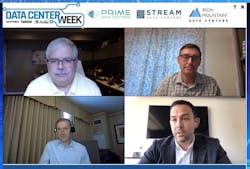As Data Center Space Grows Scarce, Enterprise Users Need to Plan Ahead
If you’re an enterprise IT user seeking to expand your data center infrastructure, you’d better be shopping ahead. Data center space is growing scarce due to a combination of historic demand from hyperscale customers and a slowdown in new construction, a trend seen in both executive commentary and leasing data.
That’s the clear takeaway from the experts on the Data Center Trends panel that I moderated at the recent Data Center Week event from Endeavor Business Media. New leasing data from datacenterHawk reinforces the new reality that space is harder to find in most major data center markets.
“Data center users in US and Canadian markets will have to make decisions faster if they want to be in control of their infrastructure future, both at the enterprise and hyperscale level,” said David Liggitt, CEO of datacenterHawk, in the company’s second-quarter market report.
Capacity planning is always challenging for enterprise users, but has been complicated by extraordinary leasing in early 2022, which has absorbed much of the available data center space. Activity has been accelerated by concerns that delivery of future capacity may be slowed by supply chain disruptions, which are beginning to cause more delays in data center construction. Hyperscale customers – a group led by Meta, Amazon Web Services, Microsoft and Google – are racing to reserve space to ensure they have room to keep growing for years. More than 1.2 gigawatts of data center space was leased or pre-leased in the first half of 2022.
The reduced inventory is likely to become more acute in the largest U.S. market in Northern Virginia, where Dominion Energy reports that ” transmission constraints in a pocket of eastern Loudoun County that will impact new connections for large customers.” The news may also prompt competition for the remaining space in Ashburn, which has one of the lowest vacancy rates for data center space in the country.
Here’s a look at what the experts are saying.
‘It’s Absolutely Crazy Out There’
The shortages of data center space are seen primarily in the wholesale sector, in which users lease capacity in suites, data halls or even entire buildings. Availability is better for buyers of colocation space, where capacity is delivered by the cabinet or cage. The boundaries between the business models has been blurring in recent years, but requirements above 1 megawatt tend to seek wholesale space, which offers greater control over the data center.
The longer lead times for procuring data center space were a hot topic in our June 23 session at Data Center Week, which featured executives from two companies that specialize in wholesale space Stream and Prime), while Iron Mountain offers both types of capacity. Here’s an excerpt from our conversation.
Rich Miller, Data Center Frontier: “If someone is thinking about deploying more data center capacity in the second half of 2022, what should they be thinking about? in getting ready to do deployments in the current environment?”
Jonathan Gibbs, Prime Data Centers: “I don’t know how to say this, but you’re behind the 8-ball. The honest truth is that it’s absolutely crazy out there. Start looking into Q1, Q2, or possibly even Q3 of 2023.”
Stuart Lawrence, Stream Data Centers: “I would echo what Jonathan’s saying. In data centers that are building out capacity for the future, you might find one or two megawatts here and there. But if you’re going to be looking for 10s of megawatts … I think those types of deployments take time. You will be looking for a partner that has their inventory already ordered and hasn’t been allocated.”
Chris Pennington, Iron Mountain Data Centers: “The first word that came to my mind was ‘pre-sold.’ There’s capacity out there, and we’re here to help and supply our customers with what they need. But space is filling up quickly. It’s definitely a robust market, and in the current conditions, people have got to order ahead.”
Jonathan Gibbs: “It seems like we’re all kind of in the same spot. Equipment and vendor relationships and the supply chain are crucial right now. This includes everyone from consultants right down to the folks that are installing cables.”
Rising Enterprise Demand Meets Tight Supply
The 2Q research from datacenterHawk, which was released last week, provides data that reinforces those comments. The vacancy rate in North American primary markets is now averaging 4.4%, its lowest point ever and the first time average has dropped below 5%.
“Enterprise users with 1- to 4-megawatt lease requirements have fewer suitable options today than they did one year ago,” wrote Liggitt. “The number of these requirements has increased as well, and when it’s coupled with demand from the hyperscale sector, these enterprise users are having to evaluate second-generation space that is priced higher today.”
That second-generation space – typically in established facilities and vacated by a previous tenant – is becoming a more important component of data center real estate. In recent years, data center providers have had growing success in re-leasing this space to new tenants, and this will become even more important in markets facing supply constraints, like Northern Virginia.
Pricing typically varies between locations and providers, but has been moving higher – a recent trend that may be with us for a while.
“Pricing increases are expected to continue as well, as data center operators deal with inflation, increase in land pricing, and leverage due to lack of option availability across most markets.”
A key question is whether the supply issues created by the enormous leasing by hyperscale users will ultimately shift more capacity onto cloud platforms, which typically offer faster deployment.
About the Author



